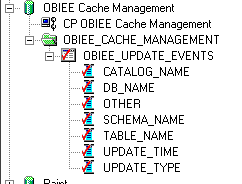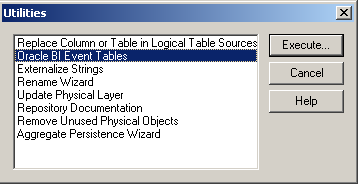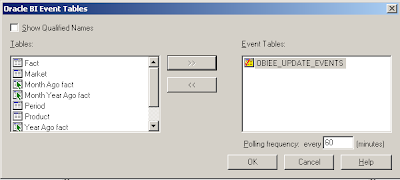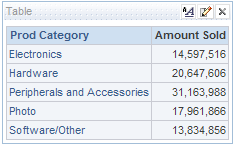getCurUser:
 getSessionEnviroment:
getSessionEnviroment:

The VB. NET source can be found here:
http://knowledge.ciber.nl/weblog/OBIEE/modSAWService002.txt
Till Next Time
A collection of OBIEE / OBISE stuff from 101 till 404. I just put the things here I run into.
 getSessionEnviroment:
getSessionEnviroment:




 Press the advanced button:
Press the advanced button:
 Add the URL enter http://localhost:9704/analytics/saw.dll?WSDL (Change the port number if needed). Later you can put the settings for this reference in a config file.
Add the URL enter http://localhost:9704/analytics/saw.dll?WSDL (Change the port number if needed). Later you can put the settings for this reference in a config file. Press GO
Press GO Till Next Time
Till Next Time Put in a basic OR filter
Put in a basic OR filter Have a look a the result:
Have a look a the result: Make a basic prompt:
Make a basic prompt: Put it all on a dashboard:
Put it all on a dashboard:  Select the year 2000:
Select the year 2000:


 Save the report and go back to your dashboard. Whatever year you select the result will not change.
Save the report and go back to your dashboard. Whatever year you select the result will not change.
____________________________
2011/08/26: Update
-- This article is based on OBIEE10g technology
-- In the original text from 2008/07/27 there was a typo in the example:
MAX_CACHE_ENTRIES = 80000 should read MAX_CACHE_ENTRIES = 800
Some of you copied the example without reading the text. This can lead to a server crash a described in tech note 1340621.1. Especially on a clustered environment.
“It appears that the "purge process" was not able to purge excessive number of cache entries. OBI Server crashes when you attempt to do so.”
It will also generated log entry like:
[47041] NQSConfig.INI warning: The value of MAX_CACHE_ENTRIES is currently 10000 and exceeds the recommended limit of 1200.
Please check any numbers against common sense and the rule of thumbs described in this article.
Till Next Time
Thnx to Stijn Gabriels for noticing and reporting this error on the blog.
____________________________
Some remarks upfront:
How does the OBIEE cache work?
The program first hashes the request string, looks in the cache directory is there is already a valid file present, if not it will execute the request against the database.
If you have a close look at your cache directory you will see that there it’s collection of “.TBL” files. If you open the file in an editor you will recognize things like, user, repository, execute request and of course the resulting data.
Cache entries will become "personal" if you have row level security inside OBIEE. One other reason for a cache entry to become personal is when you have a VPD (Virtual Private Database) in place. A good posting on this subject can be found here: http://obieeblog.wordpress.com/2008/12/29/obiee-and-virtual-private-database-vpd/
Since all the cache is written to disk, the cache directory needs to be on the quickest drive available preferable with its own disk controller.
Before we go in to detail over the possible cache settings we first have to ask ourselves what the valid reasons to use the OBIEE cache are.
Caching a report because “it takes to long” is usually a sign that your data warehouse or data mart doesn’t meet the user requirements.
The parameters for the cache management can be found in NQConfig.ini.
ENABLE
To enable the cache set the ENABLE parameter to YES.
DATA_STORAGE_PATHS
This parameters specifies one or more directory paths for where the cached query results data is stored and are accessed when a cache hit occurs. The maximum capacity in bytes, kilobytes, megabytes or gigabytes. The maximum capacity for each path is 4 GB. For optimal performance, the directories specified should be on high performance storage systems.
Each directory listed needs to be an existing, fully-qualified, writable directory pathname, with double quotes ( " ) surrounding the pathname. Specify mapped directories only.
UNC path names (“\\server.name.edu\somefolder“) and network mapped drives are allowed only if the service runs under a qualified user account. To change the account under which the service is running, see the corresponding topic in the Oracle Business Intelligence Enterprise Edition Deployment Guide.
Specify multiple directories with a comma separated list.
When you specify more than one directory, they should reside on different physical drives. (If you have multiple cache directory paths that all resolve to the same physical disk, both available and used space may be double-counted.)
Example: DATA_STORAGE_PATHS = "d:\OracleBI\cache" 256MB, “f:\OracleBI\cache" 256MB ;
OBIEE fills uses these directories alternating, request 1 goes to first directory, request 2 goes to second directory, request 3 goes to first directory etc.
some notes:
MAX_ROWS_PER_CACHE_ENTRY
Specifies the maximum number of rows in a query result set to qualify for storage in the query cache. Limiting the number of rows is a useful way to avoid using up the cache space with runaway queries that return large numbers of rows. If the number of rows a query returns is greater than the value specified in the MAX_ROWS_PER_CACHE_ENTRY parameter, the query is not cached. When set to 0, there is no limit to the number of rows per cache entry.
Default: MAX_ROWS_PER_CACHE_ENTRY = 100000 ;
Setting this any higher makes OBIEE an ETL tool.
MAX_CACHE_ENTRY_SIZE
Specifies the maximum size for a cache entry. Potential entries that exceed this size are not cached. The default size is 1 MB.
Specify GB for gigabytes, KB for kilobytes, MB for megabytes, and no units for bytes.
Example: MAX_CACHE_ENTRY_SIZE = 1 MB ; Altering this value should be done in conjunction with the setting of MAX_ROWS_PER_CACHE_ENTRY.
MAX_CACHE_ENTRIES
Specifies the maximum number of cache entries allowed in the query cache. Limiting the total number of cache entries provides another parameter with which to manage your cache storage. The actual limit of cache entries might vary slightly depending on the number of concurrent queries. The default value is 1000, maximum recommended by oracle = 1200 (higher is allowed, but don’t go overboard). Example: MAX_CACHE_ENTRIES = 1000 ;
Rule of thumb: Average number of ‘UNIQUE’ (personal and shared) reports run per “cache period” * Average ‘drill’ depth * (number of VPD users )
POPULATE_AGGREGATE_ROLLUP_HITS
Specifies whether to aggregate data from an earlier cached query result set and create a new entry in the query cache for rollup cache hits. The default value is NO.
Typically, if a query gets a cache hit from a previously executed query, then the new query is not added to the cache. A user may have a cached result set containing information at a particular level of detail (for example, sales revenue by ZIP Code). A second query may ask for this same information, but at a higher level of detail (for example, sales revenue by state). The POPULATE_AGGREGATE_ROLLUP_HITS parameter overrides this default when the cache hit occurs by rolling up an aggregate from a previously executed query, in this example, by aggregating data from the first result set stored in the cache. That is, Oracle BI sales revenue for all ZIP Codes in a particular state can be added to obtain the sales revenue by state. This is referred to as a rollup cache hit.
Normally, a new cache entry is not created for queries that result in cache hits. You can override this behaviour specifically for cache rollup hits by setting POPULATE_AGGREGATE_ROLLUP_HITS to YES.
Non rollup cache hits are not affected by this flag. If a query result is satisfied by the cache—that is, the query gets a cache hit—then this query is not added to the cache. When this parameter is set to YES, then when a query gets an aggregate rollup hit (for example, "sales by region" is answered from "sales by district, region") then the result is put into the cache. Setting this parameter to TRUE may result in better performance, but results in more entries being added to the cache.
Example: POPULATE_AGGREGATE_ROLLUP_HITS = YES ;
USE_ADVANCED_HIT_DETECTION
When caching is enabled, each query is evaluated to determine whether it qualifies for a cache hit. A cache hit means that the server was able to use cache to answer the query and did not go to the database at all. The Oracle BI Server can use query cache to answer queries at the same or later level of aggregation (Data Mart Automation).
The parameter USE_ADVANCED_HIT_DETECTION enables an expanded search of the cache for hits. The expanded search has a performance impact, which is not easily quantified because of variable customer requirements. Customers that rely heavily on query caching and are experiencing misses might want to test the trade-off between better query matching and overall performance for high user loads. Example:USE_ADVANCED_HIT_DETECTION = YES;
Reasons Why a Query is Not Added to the Cache:
MAX_SUBEXPR_SEARCH_DEPTH
The parameter MAX_SUBEXPR_SEARCH_DEPTH allows you to configure how deep the hit detector looks for an inexact match in an expression of a query. The default is 5. At the default level (5), for example, a query on the expression sin(cos(tan(abs(round(trunc(profit)))))) misses on Profit, which is at level 7. Changing the search depth to 7 opens up Profit for a potential hit. Advice set it to 99.
The [CACHE] part from your NQConfig.ini file could now look like this:
#####################################################
#
# Query Result Cache Section
#
#####################################################
[ CACHE ]
ENABLE = YES;
DATA_STORAGE_PATHS = "d:\OracleBI\cache" 1GB, “f:\OracleBI\cache" 1GB ;
MAX_ROWS_PER_CACHE_ENTRY = 10000 ;
MAX_CACHE_ENTRY_SIZE = 1 MB ;
MAX_CACHE_ENTRIES = 1200 ;
POPULATE_AGGREGATE_ROLLUP_HITS = YES;
USE_ADVANCED_HIT_DETECTION = YES;
MAX_SUBEXPR_SEARCH_DEPTH = 99;
If your OBIEE server is in a clustered environment use the following parameters for the “shared” part:
GLOBAL_CACHE_STORAGE_PATH
The physical location for storing cache entries shared across clustering. All clustering nodes share the same location.
Example: GLOBAL_CACHE_STORAGE_PATH = "
MAX_GLOBAL_CACHE_ENTRIES
The maximum number of cache entries stored in the location specified by
GLOBAL_CACHE_STORAGE_PATH.
Example: MAX_GLOBAL_CACHE_ENTRIES = 1000;
CACHE_POLL_SECONDS
The interval in seconds that each node pulls from the shared location specified in
GLOBAL_CACHE_STORAGE_PATH.
Example: CACHE_POLL_SECONDS = 300;
CLUSTER_AWARE_CACHE_LOGGING
Turns on logging for the cluster caching feature. Used only for troubleshooting. The default is NO.
Example: CLUSTER_AWARE_CACHE_LOGGING = NO;
Till Next Time


Step 4: Edit SERVER.XML
Open the file "SERVER.XML" in a editor and add reference to "secure-web-site.xml". Between the application-server tags add: {web-site path="./secure-web-site.xml" /}. Your file should look something like this:
save the file!
Step 5: an extra backup!
Add a new directory called: "backup_change_YYYYMMDDNNN" (fi:backup_change_20080723001. Copy the whole content of the config directory to the new directory. (Why?, if you not carefull during an upgrade you loose all your OC4J settings......)
Step 6: Restart OC4J
Stop and start your OC4J.
You can now run your OBIEE website from the default HTTPS adress.
Remember: All your users still have to import the certificate!
Of course you also have to alter the port number in the OBIEE config files:
...\OracleBI\oc4j_bi\j2ee\home\applications\bioffice\bioffice\WEB-INF\bioffice.xml
...\OracleBI\xmlp\XMLP\Admin\Configuration\xmlp-server-config.xml
...\OracleBIData\web\config\instanceconfig.xml
Till Next Time
This article is also published on: http://knowledge.ciber.nl/weblog/
 If you want to run the websdervice on different portnumber or even better from the default port 80, this is what you have to do.
If you want to run the websdervice on different portnumber or even better from the default port 80, this is what you have to do.

 After a small discussion: “why the hell he needed more then the OBIEE default of 100 gauges on a single screen?”, he convinced me that it was for development purposes only.
After a small discussion: “why the hell he needed more then the OBIEE default of 100 gauges on a single screen?”, he convinced me that it was for development purposes only. Till Next Time
Till Next Time
 Now assign this table as an event table:
Now assign this table as an event table: Drag the event table(s) to the right side
Drag the event table(s) to the right side Set the polling frequency, press OK.
Set the polling frequency, press OK.
 Check if the cache is actually filled:
Check if the cache is actually filled: Fill the Event table: (Based on the SH schema)
Fill the Event table: (Based on the SH schema) Note 3: OBIEE removes each entry from the EVENT table independent if it was a success or not.
Note 3: OBIEE removes each entry from the EVENT table independent if it was a success or not.


Uncheck:
Require fully qualified table names
Shared logon
Enable connection pooling
Use multithreaded connections
Execute queries asynchronously
Check:
Parameters supported
Set:
Parameters supported to Repeatable read
Step 3:
Deselect the cacheable checkbox
Now when you have made a change to your Excel sheet you only have to press the refresh button in your OBIEE report:
Oracle Business Intelligence displays the results of the request when editing most views within Answers. If you prefer that the user explicitly ask to view
the results, you can create an XML message that specifies that auto-preview
should be disabled when new views are created. The user can still click the display results link to view the results when editing a view.
! Save the file and restart the presentation server.
Now all the autopreview is switched off:
 Till Next Time
Till Next Time